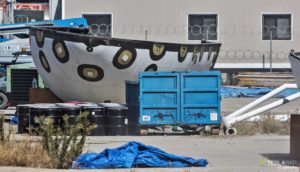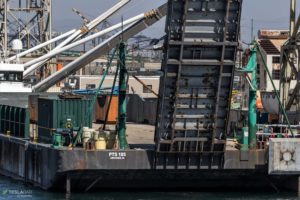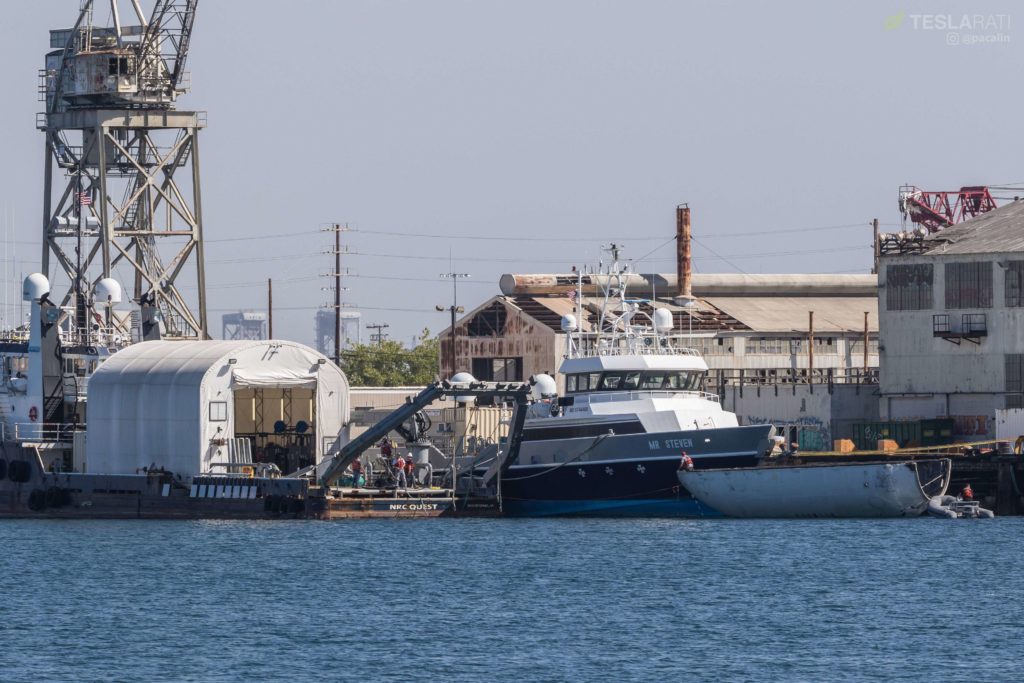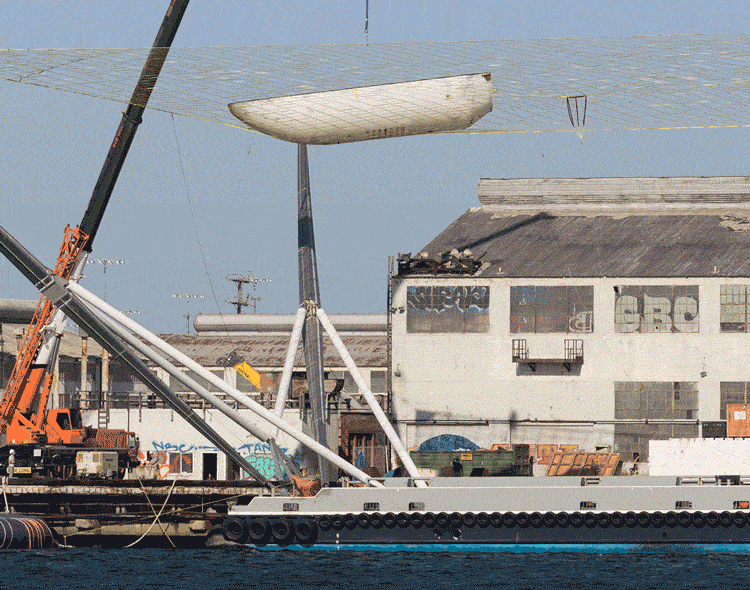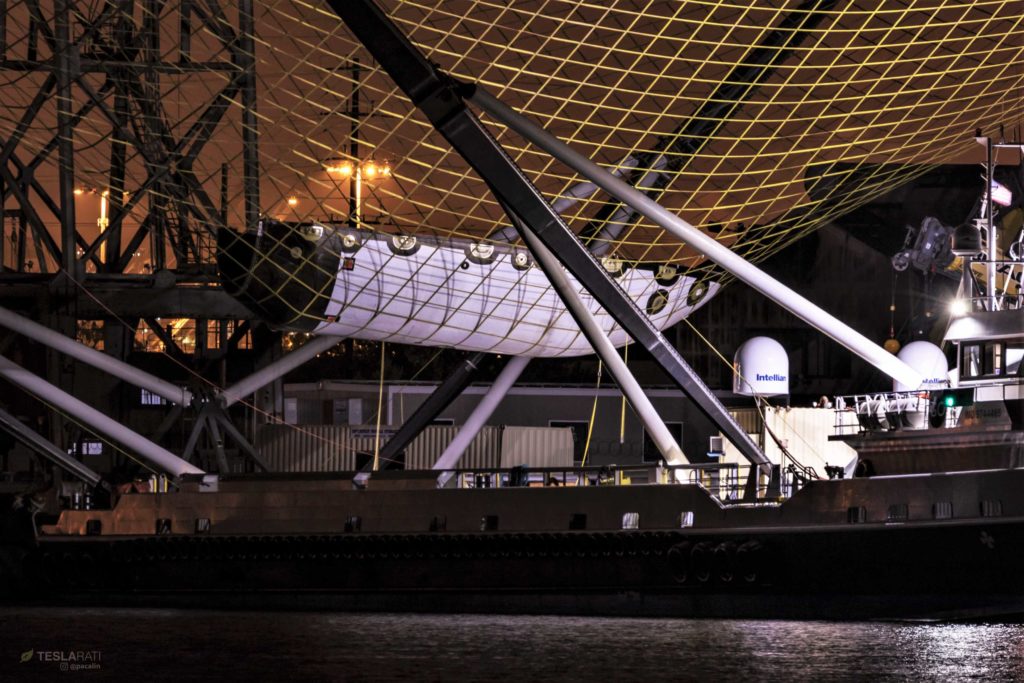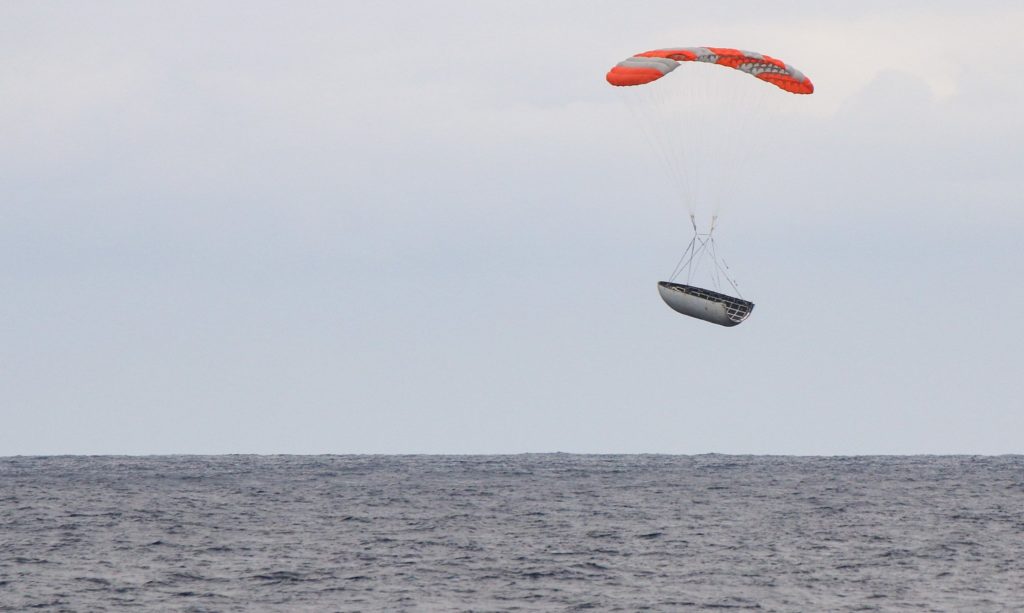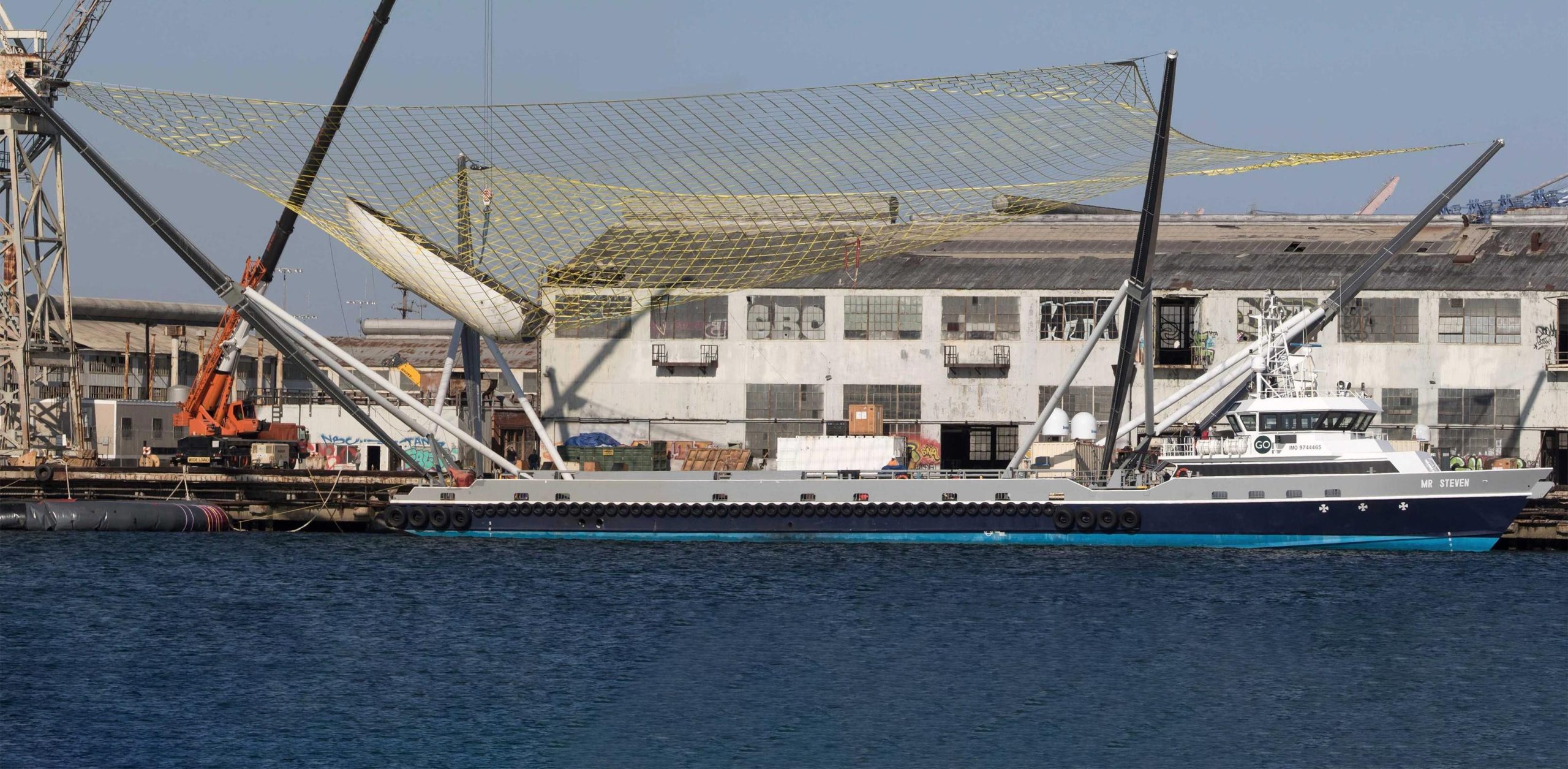
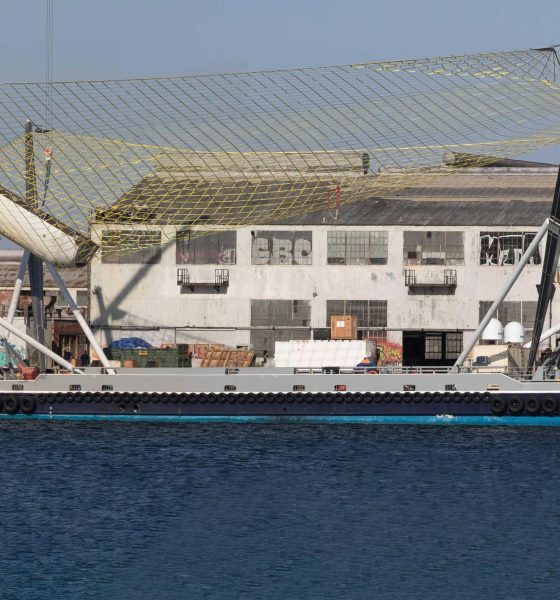
News
SpaceX attempts second Falcon fairing drop test with a helicopter and Mr. Steven
Following a few days of rest in port, SpaceX fairing recovery vessel Mr. Steven has continued a likely campaign of controlled drop tests with a second fairing recovery attempt, using a helicopter, spotter plane, and support vessel to pick up a Falcon fairing and drop it, theoretically allowing it to paraglide into Mr. Steven’s net.
While it’s nearly impossible to determine what happened without line-of-sight visual confirmation or an official announcement from SpaceX, it appears that Mr. Steven kicked off real catch attempts on October 11th, evidenced by his close interaction with a Blackhawk helicopter over the course of an hour or so. Another similar attempt occurred today, October 17th, and culminated with Mr. Steven returning once more to Port of San Pedro with the same test-focused fairing half on board, albeit not resting in his retracted net.
- SpaceX’s dedicated test fairing seen at Berth 240 on Oct. 15, a few days after its first apparent drop test. (Pauline Acalin)
- Mr. Steven and a recent arrival, barge PTS 185. The fairing cradle on deck suggests that this is probably the platform helicopters grab the fairing half off of. (Pauline Acalin)
After October 11th’s testing was completed, Mr. Steven returned to Port of San Pedro. On October 13th, he was docked at SpaceX’s Berth 240 facilities with net lowered and the test fairing half wrapped up on the docks, preventing confirmation of whether he carried the fairing half back from the testing region. A mid-sized barge also recently appeared at Berth 240 with a distinct Falcon fairing cradle onboard, perhaps explaining the presence of a tugboat (named Sir Richard) a few miles away from where this test campaign has been stationed – a barge would offer a flat, safe surface for a helicopter to hover over and pick up an unwieldy object such as a payload fairing.
Nearly identical to the October 11th test, Mr. Steven, tug Sir Richard, a Cessna chase plane, and a Blackhawk helicopter all converged around 100 miles southwest of Port of Los Angeles around 2pm PDT on October 17th prior to beginning recovery test operations. Mr. Steven and the tug Sir Richard – likely towing a barge being temporarily used to move a fairing half – arrived several hours beforehand at the test’s planned location.
- As of late, SpaceX technicians and engineers have going through quite a range of activities related to fairing recovery. (Pauline Acalin)
- A gif demonstrates just how taut Mr Steven’s net can be, thanks to mechanized rigging. 08/13/18 (Pauline Acalin)
- Mr. Steven returned to Port of San Pedro around 7pm on October 8th after a day spent at sea, apparently with a Falcon fairing half in tow. This is the second known time that a fairing has been in Mr. Steven’s net. (Pauline Acalin)
- One half of SpaceX’s Iridium-6/GRACE-FO just moments before touchdown on the Pacific Ocean. (SpaceX)
Eventually, a UH-60A Blackhawk helicopter – the same helicopter used on October 11 – lifted off from Catalina Island’s Avalon airport, taking about half an hour to reach Mr. Steven and Sir Richard. Once there, the helicopter very distinctly slowed down, eventually hovering just ~20 feet off the surface of the ocean, if not outright landing or perching on the aforementioned barge under the tug’s control. After several minutes in that state, the Blackhawk lifted off and immediately began climbing, reaching a peak of ~11,000 ft before (presumably) dropping its fairing payload and immediately diving down to follow its descent.
It’s undoubtedly an imperfect fit, but the helicopter appeared to follow Mr. Steven very closely over the course of the recovery attempt, sticking just a ~1500 ft or less above and a few hundred feet beside him as he raced to catch the falling fairing half. In fact, at least as a very rough approximation, the helicopter’s descent may be useful to judge the fairing’s behavior while gliding: taking ~14 minutes to travel descend 11,000ft and travel perhaps 2 miles (~10,500ft) horizontally, the fairing would dropped at a reasonable 13.1 feet per second (~4 m/s) once its parafoil opened and seemed to travel approximately one foot forward for every one foot down, also known as a 1:1 glide slope ratio.
And here's a little overview of the helicopter's path, mixed with a speed/altitude graph! Added some rough annotations to give an idea of what happened and in what time frame 😀 pic.twitter.com/e1rwZtkNHA
— Eric Ralph (@13ericralph31) October 18, 2018
Depending on wind conditions, parafoils can nominally be expected to achieve average glide slope ratios between 0 (high winds; falling like a literal rock) and 4 (no winds; almost as good as a bad airplane), meaning that Falcon fairings – judging from tangential data gathered from the helicopter following its descent – fly much like a parafoil, which is to say not great but better than a brick. The trick with parafoil control – which includes tweaking angles of attack and glide slope – lies more in the art of trading forward velocity for vertical velocity (or vice versa) at key moments. Assuming their control mechanisms have enough authority, paragliding fairings could ‘flare’ as they near Mr. Steven’s net, essentially angling upwards to briefly hover before dropping quickly, maybe giving the boat enough time to swoop in and place its net just beneath it.
In this way, a parafoil’s flexible, inflated wing (airfoil, to be precise) can allow it to maneuver quite a lot like a bird, at least more so than most other methods of flying humans have access to. Time will tell if SpaceX is having any luck perfecting the guidance and recovery of Falcon fairings, particularly with this campaign of under-the-radar drop tests. Even if Mr. Steven returns with a fairing half resting in his net, it will be more than a little ambiguous if it was placed there or he caught it, and any certainty will rely on official confirmation from SpaceX itself.
For prompt updates, on-the-ground perspectives, and unique glimpses of SpaceX’s rocket recovery fleet check out our brand new LaunchPad and LandingZone newsletters!

News
Tesla hints at Starlink integration with recent patent
“By employing polymer blends, some examples enable RF transmission from all the modules to satellites and other communication devices both inside and outside the vehicle.”

Tesla hinted at a potential Starlink internet terminal integration within its vehicles in a recent patent, which describes a vehicle roof assembly with integrated radio frequency (RF) transparency.
The patent, which is Pub. No U.S. 2025/0368267 describes a new vehicle roof that is made of RF-transparent polymer materials, allowing and “facilitating clear communication with external devices and satellites.”
Tesla believes that a new vehicle roof design, comprised of different materials than the standard metallic or glass elements used in cars today, would allow the company to integrate modern vehicular technologies, “particularly those requiring radio frequency transmission and reception.
Tesla has recently filed a US patent application on integrating RF transparent materials into the roof structure.
“facilitating clear communication with external devices and satellites”
Tesla fleet is getting @Starlink connectivity integration soon. LFG @Tesla @elonmusk… pic.twitter.com/bLa8YtPLd1
— Chansoo Byeon (@Chansoo) December 9, 2025
Instead of glass or metallic materials, Tesla says vehicles may benefit from high-strength polymer blends, such as Polycarbonate, Acrylonitrile Butadiene Styrene, or Acrylonitrile Styrene Acrylate.
These materials still provide ideal strength metrics for crashworthiness, stiffness for noise, vibration, and harshness control, and are compliant with head impact regulations.
They would also enable better performance with modern technologies, like internet terminals, which need an uninterrupted signal to satellites for maximum reception. Tesla writes in the patent:
“By employing polymer blends, some examples enable RF transmission from all the modules to satellites and other communication devices both inside and outside the vehicle.”

One of the challenges Tesla seems to be aware of with this type of roof design is the fact that it will still have to enable safety and keep that at the forefront of the design. As you can see in the illustration above, Tesla plans to use four layers to increase safety and rigidity, while also combating noise and vibration.
It notes in the patent that disclosed examples still meet the safety requirements outlined in the Federal Motor Vehicle Safety Standards (FMVSS).
Starlink integrated directly into Tesla vehicles would be a considerable advantage for owners. It would come with a handful of distinct advantages.
Initially, the inclusion of Starlink would completely eliminate cellular dead zones, something that is an issue, especially in rural areas. Starlink would provide connectivity in these remote regions and would ensure uninterrupted service during road trips and off-grid adventures.
It could also be a critical addition for Robotaxi, as it is crucial to have solid and reliable connectivity for remote monitoring and fleet management.
Starlink’s growing constellation, thanks to SpaceX’s routine and frequent launch schedule, will provide secure, stable, and reliable internet connectivity for Tesla vehicles.
Although many owners have already mounted Starlink Mini dishes under their glass roofs for a similar experience, it may be integrated directly into Teslas in the coming years, either as an upgrade or a standard feature.
News
Tesla supplements Holiday Update by sneaking in new Full Self-Driving version
It seems Tesla was waiting for the Hardware 4 rollout, as it wanted to also deploy a new Full Self-Driving version to those owners, as it appeared in the release notes for the Holiday Update last night.

Tesla has surprised some owners by sneaking in a new Full Self-Driving version with the wide release of the Holiday Update, which started rolling out to Hardware 4 owners on Friday night.
Tesla has issued a controlled and very slow release pattern with the Holiday Update, which rolls out with Software Version 2025.44.25.5.
For the past two weeks, as it has rolled out to Hardware 3 and older Tesla owners, the company has kept its deployment of the new Software Version relatively controlled.
It seems Tesla was waiting for the Hardware 4 rollout, as it wanted to also deploy a new Full Self-Driving version to those owners, as it appeared in the release notes for the Holiday Update last night.
Tesla Full Self-Driving v14.2.1.25 made its first appearance last night to Hardware 4 owners who are members of the Early Access Program (EAP). It appears to be a slight refinement from FSD v14.2.1, which has been out for a couple of weeks.
Tesla v2025.44.25.5 Holiday update incoming
Also Full Self-Driving v14.2.1.25!!! pic.twitter.com/74D7S0UGXz
— TESLARATI (@Teslarati) December 13, 2025
Many owners welcome the new FSD version, us included, because we’ve been less than impressed with v14.2.1. We have experienced some minor regressions with v14.2.1, especially with Speed Limit recognition, Speed Profile tinkering, and parking performance.
As it stands, Full Self-Driving is still particularly impressive, but Tesla is evidently having an issue with some of the adjustments, as it is still refining some of the performance aspects of the suite. This is expected and normal with some updates, as not all of them are an improvement in all areas; we routinely see some things backtrack every once in a while.
This new FSD version is likely to take care of those things, but it also includes all of the awesome Holiday Update features, which include:
- Grok with Navigation Commands (Beta) – Grok will now add and edit destinations.
- Tesla Photobooth – Take pictures inside your car using the cabin-facing camera
- Dog Mode Live Activity – Check on your four-legged friend on your phone through periodic snapshots taken of the cabin
- Dashcam Viewer Update – Includes new metrics, like steering wheel angle, speed, and more
- Santa Mode – New graphics, trees, and a lock chime
- Light Show Update – Addition of Jingle Rush light show
- Custom Wraps and License Plates – Colorizer now allows you to customize your vehicle even further, with custom patterns, license plates, and tint
- Navigation Improvements – Easier layout and setup
- Supercharger Site Map – Starting at 18 pilot locations, a 3D view of the Supercharger you’re visiting will be available
- Automatic Carpool Lane Routing – Navigation will utilize carpool lanes if enabled
- Phone Left Behind Chime – Your car will now tell you if you left a phone inside
- Charge Limit Per Location – Set a charge limit for each location
- ISS Docking Simulator – New game
- Additional Improvements – Turn off wireless charging pad, Spotify improvements, Rainbow Rave Cave, Lock Sound TRON addition
Tesla also added two other things that were undocumented, like Charging Passport and information on USB drive storage to help with Dashcam.
Cybertruck
Tesla updates Cybertruck owners about key Powershare feature

Tesla is updating Cybertruck owners on its timeline of a massive feature that has yet to ship: Powershare with Powerwall.
Powershare is a bidirectional charging feature exclusive to Cybertruck, which allows the vehicle’s battery to act as a portable power source for homes, appliances, tools, other EVs, and more. It was announced in late 2023 as part of Tesla’s push into vehicle-to-everything energy sharing, and acting as a giant portable charger is the main advantage, as it can provide backup power during outages.
Cybertruck’s Powershare system supports both vehicle-to-load (V2L) and vehicle-to-home (V2H), making it flexible and well-rounded for a variety of applications.
However, even though the feature was promised with Cybertruck, it has yet to be shipped to vehicles. Tesla communicated with owners through email recently regarding Powershare with Powerwall, which essentially has the pickup act as an extended battery.
Powerwall discharge would be prioritized before tapping into the truck’s larger pack.
However, Tesla is still working on getting the feature out to owners, an email said:
“We’re writing to let you know that the Powershare with Powerwall feature is still in development and is now scheduled for release in mid-2026.
This new release date gives us additional time to design and test this feature, ensuring its ability to communicate and optimize energy sharing between your vehicle and many configurations and generations of Powerwall. We are also using this time to develop additional Powershare features that will help us continue to accelerate the world’s transition to sustainable energy.”
Owners have expressed some real disappointment in Tesla’s continuous delays in releasing the feature, as it was expected to be released by late 2024, but now has been pushed back several times to mid-2026, according to the email.
Foundation Series Cybertruck buyers paid extra, expecting the feature to be rolled out with their vehicle upon pickup.
Cybertruck’s Lead Engineer, Wes Morrill, even commented on the holdup:
As a Cybertruck owner who also has Powerwall, I empathize with the disappointed comments.
To their credit, the team has delivered powershare functionality to Cybertruck customers who otherwise have no backup with development of the powershare gateway. As well as those with solar…
— Wes (@wmorrill3) December 12, 2025
He said that “it turned out to be much harder than anticipated to make powershare work seamlessly with existing Powerwalls through existing wall connectors. Two grid-forming devices need to negotiate who will form and who will follow, depending on the state of charge of each, and they need to do this without a network and through multiple generations of hardware, and test and validate this process through rigorous certifications to ensure grid safety.”
It’s nice to see the transparency, but it is justified for some Cybertruck owners to feel like they’ve been bait-and-switched.
